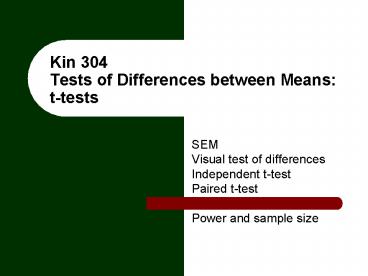Kin 304 Tests of Differences between Means: ttests - PowerPoint PPT Presentation
1 / 19
Title:
Kin 304 Tests of Differences between Means: ttests
Description:
Hypothesis: Students with or without eye glasses differ in mean exam scores. Eye Glasses mean X=85 s=12.5 n=8; No Eye Glasses mean X=79 s=13.1 n=8; Critical value of t: ... – PowerPoint PPT presentation
Number of Views:28
Avg rating:3.0/5.0
Title: Kin 304 Tests of Differences between Means: ttests
1
Kin 304Tests of Differences between Means
t-tests
- SEM
- Visual test of differences
- Independent t-test
- Paired t-test
- Power and sample size
2
Comparison
- Is there a difference between two or more groups?
- Test of difference between means
- t-test
- only two means
- ANOVA - Analysis of Variance
- Multiple means
- ANCOVA
- Includes covariates
3
Standard Error of the Mean
Describes how confident you are that the mean of
the sample is the mean of the population
4
Visual Test of Significant Difference between
Means
1 Standard Error of the Mean
1 Standard Error of the Mean
Overlapping standard error bars therefore no
significant difference between means of A and B
A
B
Mean
No overlap of standard error bars therefore a
significant difference between means of A and B
at about 95 confidence
5
Independent t-test
- Two independent groups compared using an
independent T-Test (assuming equal variances and
normality of populations) - e.g. Height difference between men and women
- The t statistic is calculated using the
difference between the means in relation to the
variance in the two samples - A critical value of the t statistic is based
upon sample size and probability acceptance level
(found in a table at the back of a stats book or
part of the EXCEL t-test report, or SPSS output) - the calculated t based upon your data must be
greater than the critical value of t to accept
a significant difference between means at the
chosen level of probability
6
t statistic quantifiesthe degree of overlap of
the distributions
7
Calculation of the t statistic
- The t statistic is calculated as the ratio of the
difference between sample means to the standard
error of the difference.
8
Assumptions of the t test
- Dependent variable is distributed normally in the
population - (robust ok if non-normal)
- Continuity of dependent variable
- (but ordinal scale is ok)
- Randomized samples from populations and of
subjects to treatments (if not, cannot
generalize) - Homoscedasticity
- particularly problematic if sample sizes are not
equal
9
Characteristics of the t distribution
- The difference between sample means, when divided
by the standard error of the difference between
means, adheres to a Normal distribution only for
very large N. - For smaller N (lt100), the more accurate
distribution for the difference between means is
the t distribution
10
t statistic
In general
where
11
t statistic
If n1 n2
There is a unique t distribution for each sample
size. The distribution is defined by the degrees
of freedom (df), where df (n1-1)(n2-1)
12
Critical values of t
- Hypothesis
- There is a difference between means
- Degrees of Freedom 2n 2
- tcalc gt tcrit significant difference
13
Example of Independent t-test
- Hypothesis Students with or without eye glasses
differ in mean exam scores - Eye Glasses mean X85 s12.5 n8
- No Eye Glasses mean X79 s13.1 n8
- Critical value of t
- df14, alpha0.05 two-tailed2.145
- Therefore there is insufficient evidence to
reject Ho
14
Paired Comparison
- Paired t Test
- Sometimes called t-test for correlated data
- Typically used for measurements repeated on the
same subject - Pretest vs. posttest Experiments
- Bilateral Symmetry
15
Paired t-test (correlated)
- Hypothesis
- Is the mean of the differences between paired
observations significantly different than zero? - df (n-1), where n number of paired
observations
16
9 Subjects All Lose Weight
Mean of differences 1.13
17
(No Transcript)
18
(No Transcript)
19
Calculation of Power or Sample Size
- Use of interactive software
- Needed for sample size calculation
- estimates of the 2 group means
- estimates of the 2 group standard deviations
- alpha and statistical power desired
- If power is to be determined, sample size
estimates are given instead - Refer to http//statpages.org/































